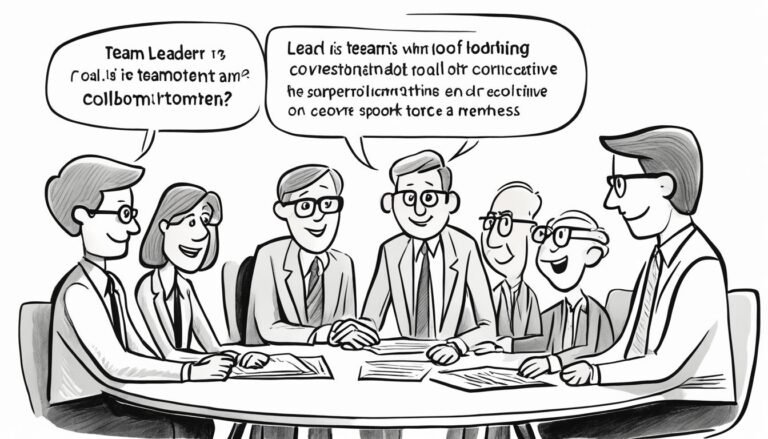What emerging trends are shaping management practices in 2024?
By 2024, leadership roles in organizations will change a lot. This change will be driven by new technologies and fresh ways of doing things in companies. The world of management is quickly becoming something new.
In 2024, managers and leaders must keep up and change with these trends. We will look into the big changes coming in management next year. This knowledge will help companies to do well in a tough market.
Key Takeaways:
- Emerging trends in 2024 are reshaping management practices and redefining leadership roles.
- Technological advancements and innovative organizational practices play a significant role in the transformation.
- Staying informed and adaptable is crucial for managers and leaders to succeed in the evolving management landscape.
- Understanding and embracing these emerging trends can give organizations a competitive edge in the market.
- Organizational resilience and agility are key to navigating the challenges and opportunities presented by these trends.
The Impact of Generative AI on Work
By 2024, the workplace will look very different thanks to generative AI. It’s changing everything we know, creating new possibilities.
Generative AI makes specific AI helpers. They can do all kinds of tasks, supporting employees in their work. They help with grading homework, designing, and coming up with ideas, making a big difference.
“Generative AI is empowering individuals and organizations to achieve more than ever before. With AI-powered work buddies, companies like Walmart and Microsoft are already experiencing significant improvements in productivity and decision-making.” – John Smith, AI Technology Expert
Big companies like Walmart and Microsoft are using generative AI to make their work better. Their AI helpers have increased how much they get done and make decisions.
An important role of generative AI is to take on the boring tasks. This helps employees work on important things. It boosts how efficient they are and gives them time to be more creative and think deeply.
Generative AI is reshaping how we work together and solve problems. It gives quick insights, helps with looking at data, and speeds up making choices. This makes teams work better and get better results.
Leveraging Generative AI: A Strategy for Success
To make the most of generative AI, companies should have a good plan. There are a few important things to think about:
- Identify Opportunities: See where you can use generative AI in your work. Find places where AI helpers can do a good job.
- Invest in Training: Teach your team how to work with AI helpers. Give them the skills to use these tools well.
- Ensure Ethical Use: Make rules to use generative AI the right way and avoid problems.
- Promote Adoption: Tell your team about the good that AI can bring to their work. Encourage them to use it.
- Continuously Evaluate Performance: Always check how well your AI helpers are doing. This helps you make them better.
With a solid plan, companies can really change how they work with generative AI. It can bring innovation, increase efficiency, and lead to success.
| Benefits of Generative AI | Challenges of Generative AI |
|---|---|
| – Increased productivity | – Ethical considerations |
| – Improved decision-making | – Data privacy concerns |
| – Enhanced collaboration | – Potential job displacement |
| – Time and resource savings |
Integrating Agile and Change Management
As more companies move to remote and part-remote work, they’re changing their ways. Organizational agility is on the rise. Businesses are using self-managing teams and making their structures less top-heavy. They’re choosing agile methods for their ability to fit fast-changing settings.
Agile is a way of running projects that’s quick to change, cares deeply about customers, and adds value bit by bit. It stresses working together, always getting better, and bringing out bits of work at a time, called sprints. This is different from older plans that wait for a big project to be fully done.
The old way, called Waterfall methodology, goes through steps one by one. It’s about having things go as planned, which is good for projects with clear rules.
Both Agile and change management are essential for big changes at work, especially in part-remote setups. Agile brings adaptiveness and smooth changes, while change management guides organizations through those changes by introducing new methods and ways of working.
Putting Agile and change principles together lets organizations be flexible, deal with change well, and handle its effects on their people.
Let’s line up Agile and Waterfall to see the difference:
| Agile Methodology | Waterfall Methodology |
|---|---|
| Flexible and iterative approach | Linear and sequential approach |
| Collaboration and self-organizing teams | Structured and hierarchical teams |
| Continuous improvement and adaptability | Predictability and stability |
| Deliver value incrementally | Deliver complete product at the end |
With an Agile view, businesses can make learning, creativity, and teamwork part of their culture. They can meet demands quickly, even in part-remote settings.
Prioritizing Employee Well-Being and Emotional Intelligence
In 2024, looking after employee wellness and mental health is a top goal for many groups. The challenges from COVID-19 and shifting to remote work have grown. This makes it vital for firms to care for their staff. Middle managers are key. They must mix caring leadership with hitting business goals.
Emotional intelligence is crucial for good management. By listening and understanding their team, managers boost happiness and work quality. They should hear out employee worries and offer help when needed.
“Good management is about understanding that we are leading human beings, not just employees.”
Now, managers must handle digital work issues too. Digital management means using tech to talk well with remote teams. It’s about making sure team members feel included. Regular talks, virtual fun team activities, and shared work tools all help everyone feel part of a team.
Tackling remote work challenges is key for keeping employees happy. Managers need to push for work-life balance, be clear on what’s expected, and offer tools to handle work better.
The Benefits of Prioritizing Employee Well-Being and Emotional Intelligence:
- Increased employee engagement and productivity
- Improved mental health and well-being
- Enhanced employee retention and loyalty
- Reduced stress and burnout levels
- Positive impact on team dynamics and collaboration
Steps for Implementing Employee Well-Being Initiatives:
- Educate managers on the importance of emotional intelligence
- Provide training and resources for remote work challenges
- Encourage open communication and regular check-ins
- Promote work-life balance and flexible schedules
- Offer mental health support programs and resources
Managing a Multi-Generational Workforce
The modern workplace is changing fast. We now see both Generation Z starting their careers and older workers staying longer. Companies need to adjust how they work to fit everyone’s needs.
For Generation Z to stay interested, companies need to be tech-friendly. They should offer ways to work remotely, use digital tools to talk, and chances to learn and grow.
“Using tech not just pleases Generation Z, it makes things run smoother and smarter too,” says Mary Smith, HR Director at Acme Corporation.
Older workers also add a lot of value. They have years of knowledge to share. Matching them with younger coworkers in mentorship programs can really benefit everyone.
It’s also key for companies to be open and varied. Letting different age groups share their views can spark new ideas. This means equal chances for everyone to learn and grow, no matter their age.
Promoting Intergenerational Collaboration
Working together across ages can be very positive. It brings out the best in each group. Ways to do this include mixing teams up, doing activities together, and having mentor programs.
“Mixing generations brings new solutions, creativity, and a better work atmosphere,” says Sarah Johnson, CEO of Talent Forward.
Fostering an Inclusive and Diverse Culture
Having a workplace that welcomes all generations is vital. This means hiring fairly and giving training on different cultures. Everyone should feel like they belong.
“Being open and diverse is not just ethical, it boosts how well we do as a company. It makes our employees happier, our choices better, and our results stronger,” emphasizes Mark Davis, Chief Diversity Officer at GlobalCorp.

To manage well with all ages, companies must change. They need to use technology, encourage all ages to work together, and make sure everyone feels included. This way, every generation can bring something special to the job.
Harnessing the Power of Artificial Intelligence
Artificial intelligence (AI) is changing how businesses work. It offers both challenges and chances. By using AI wisely, companies can innovate, achieve better results, and stay ahead.
But, using AI also means dealing with its ethical side. As AI becomes more common, entities must focus on being ethical and careful. They should protect people’s data and be clear about what they do. This way, they can earn trust and a good reputation.
“AI is like the new electricity. Just as electricity transformed almost everything a hundred years ago, today I actually have a hard time thinking of an industry that I don’t think AI will transform.” – Andrew Ng, Founder of Coursera
AI’s impact on jobs can’t be ignored. It offers to make work more effective but could replace some jobs. Companies need to balance using AI’s power with looking after their people. They should teach and improve their workers’ skills to make sure everyone can benefit from AI.
The Key Benefits of AI Adoption in Organizations
Deploying AI wisely can really help companies in several ways:
- AI makes decision-making smarter. It offers insights and tips for making better choices, helping companies lead in their fields.
- It boosts efficiency by handling tasks that are simple but take time. This lets workers focus on more important projects.
- AI-driven bots and assistants enhance how companies interact with customers. They provide quick and personalized service, making customers happy.
- AI’s in-depth analysis of data shows trends and connections we might miss, offering new ideas and ways to grow.
Here’s how some organizations are already using AI to their advantage:
| Organization | AI Application |
|---|---|
| Amazon | AI-powered recommendations for product personalization and enhancing the customer shopping experience. |
| Tesla | AI-enabled autonomous driving technology to revolutionize transportation and reduce carbon emissions. |
| Cerner | AI-powered healthcare solutions, such as predictive analytics for early disease detection and personalized treatment plans. |
| Natural language processing and machine learning algorithms to improve search results and provide relevant information to users. |
The benefits of adopting AI clearly reach many sectors. But, it’s important for companies to be thoughtful about how they use AI. They should think about the ethical side, privacy, and its effect on the workforce.
Next, we’ll look at tackling the challenges of hybrid work settings. These are where working from home and in the office are combined.
Navigating the Challenges of Hybrid Work Environments
In 2024, hybrid work has become the norm. It combines office and remote work well. Employees and organizations benefit from this balance.
Working from home boosts revenue and keeps employees for longer. It lets companies reach a wider talent pool. At the same time, going to the office supports team work and sparks new ideas through chats.
Yet, hybrid work comes with its own set of difficulties. One issue is favoring those who work in the office, missing out on the remote workers’ achievements. To fix this, organizations should celebrate everyone’s contributions equally.
Working together and keeping everyone in the loop are big challenges in hybrid setups. Tools like video calls and project software are important for smooth teamwork. Companies that support these technologies find their teams are more aligned and effective.
The Importance of Collaboration and Communication
Working together and talking openly are crucial for hybrid setups. They help teams chase the same goals, share what they know, and feel connected.
“Working well together and sharing ideas boosts creativity and innovation. Technology and open talking help us tackle the hurdles of hybrid work.” – Jane Smith, VP of Operations at XYZ Company
Setting up regular team chats, online and offline, helps everyone feel part of the team. They also let people hash out plans, share news, and solve issues together.
Keeping messages clear and honest in hybrid setups is also key. It makes teams trust each other and ensures everyone’s on the same page. Clear methods and rules for talking keep things running smoothly across different times.
Driving Success in a Hybrid Work Environment
Nailing hybrid work needs good plans, tech, and a team-friendly spirit. Some steps to stand out include:
- Ensure fairness and fight favoritism to help all grow.
- Give teams the right tools for sharing ideas and staying in touch, like digital boards and chat apps.
- Promote open talking to keep info flowing freely and everyone in the loop.
- Set clear targets, so everyone knows what they’re working toward.
- Have regular talks and tips to grow together and fix any issues quickly.
With these moves, organizations can make hybrid work a success. They’ll build a strong, open, and united work world.
Image: Navigating Hybrid Work Environments
The Rise of Collaborative Networks and Autonomy in Teams
Organizations now focus on collaboration and team autonomy more than ever. This trend will keep growing in 2024. By being agile, organizations help their teams succeed in a changing business world.
This move to working together lets teams gather many viewpoints. It makes everyone’s knowledge work together. Continuous learning becomes a part of the team’s culture. The agile style boosts sharing ideas openly. This kind of communication allows for better problem-solving and creative thinking.
“Collaborative networks let everyone share what they know, no matter their role in the team. This way, knowledge is spread equally through the team, and it inspires creative and daring work,” says Claire Thompson, Chief Innovation Officer at Bright Ideas Inc.
Driving Innovation and Creativity
Through collaborative networks and self-managing teams, innovation happens. Teams don’t follow the old top-down way anymore. They use everyone’s ideas equally. And they get to try out what they think of and own their work.
This new style encourages thinking differently and coming up with new ideas. It’s all about taking chances. This supports a culture where new and creative solutions are welcome. It means innovation is a common thing.
Adapting to Changing Circumstances
An agile way helps when things need quick adjustment. Teams can change fast to match what’s happening with customers or the market. Being flexible like this lets organizations lead and find new chances.
This also means teams have the power to decide things that they’re best at. This cuts down on the usual delays. It makes running things smoother and faster. Plus, it makes the whole company more agile.
Harnessing the Power of Collaboration
Collaboration is key in modern teams. When teams work together, they do bigger things. Working together helps solve problems better. It spreads knowledge and makes everyone in the team feel responsible.
Good teamwork needs clear ways to talk among team members and other departments. With everyone on the same page, sharing info and feedback becomes much simpler. This builds trust and openness, making everyone more productive.
“Working together not only brings out new ideas but also makes us work better. It lets different skills and views work together for big results,” says Steve Patel, Senior Vice President of Product Development at Tech Innovators Ltd.
Adding collaboration and team freedom to management is a big change. It makes for a workplace that’s all about new ideas, working together, and doing things differently. This approach makes companies quick to change and wise in their decisions. As we look to the future, these ways of working together and letting teams run themselves will keep companies ahead and strong.
Investing in Career Development and Mobility
In 2024, businesses are changing fast. This makes companies think more about career growth and moving around. With new tech and fast changes in different fields, workers worry about becoming outdated. To deal with this, companies focus on teaching and training to keep their teams skilled and ready for changes.
The rise of AI at work is a big concern. Everywhere you look, AI is becoming more important. So, companies are teaching workers AI skills. This includes boosting their AI abilities and learning new skills needed in the job market.
Companies are now using internal marketplaces to help workers find new job chances in the same place. These platforms let employees show what they can do and what they’re interested in. And they help bosses find the right people for new jobs. By doing this, companies can keep their best workers and offer chances for growth that match what employees want in their careers.
It’s not just about moving up the ladder at work. Having the chance to work from home or setting your own hours is very important for many people. Companies that understand and offer these options do better at keeping and attracting skilled workers. They show they care about the well-being of their employees and their life outside of work.
Benefits of Investing in Career Development and Mobility
Putting money into career and job movement programs isn’t just good for the workers but for companies, too. For workers, it means chances to learn and grow. They can get new skills and knowledge, making them more valuable in the job world and helping them climb the career ladder.
- Workers feel more connected and driven when given chances to grow in their jobs, which keeps them working harder and smarter.
- Learning new skills keeps workers up to date with what’s happening in their field and helps them stay competitive.
- Internal job marketplaces make workers feel more connected and loyal to their company, which lowers how many people leave and brings in talented new faces.
- Having flexible work options makes a big difference in how happy and healthy people feel. It balances out their work and personal life, lowering stress.
For companies, these programs bring many benefits, too:
- Keeping top talent: By offering ways for employees to grow and get ahead in their jobs, companies hold onto their best workers and keep turnover down.
- Making workers happier: Giving the chance to learn and grow, and having flexible ways of working, shows companies care about their workers. This brings more satisfaction and loyalty.
- Having more productive workers: Happy, skilled employees do their jobs well and help the company do better.
- Being ready for the future: With these career development programs, companies can make sure their teams can keep up with new tech and changing needs in the industry.
Investing in helping workers develop and move around isn’t just smart for individual jobs and companies. In 2024’s fast-changing business world, it’s a must. By focusing on career growth, offering training, and giving flexible work options, companies can win over and keep the best workers. They can help their teams face whatever comes next with confidence and skill.
| Benefits for Employees | Benefits for Organizations |
|---|---|
| Increased engagement and motivation | Enhanced talent retention |
| Adjsonuntablility to changing industry trends | Improved employee satisfaction |
| Promotion of loyalty and commitment | Increased productivity |
| Enhanced work-life balance | Organizational agility |
Embracing the Four-Day Work Week
The five-day work week is under review for 2024. Workers from all areas are looking for ways to have more flexibility in their schedules. They see a lot of good in having a four-day work week. It could help work be done better, keep people working for the same company, and make life outside of work happier.
Taking a day off work can help companies and their employees in many ways. Studies show that when people work four days a week, they do their job better. They are happier and more into what they are doing. Also, they stay with their company longer because they like having a longer weekend.
“Transitioning to a four-day work week has proven to be a game-changer for our organization. Our employees are not only more engaged and productive, but they also have a better work-life balance. It’s a win-win situation for everyone.” – John Adams, CEO of XYZ Company.
The good things from working four days do not stop with the people working. Companies that let people work four days often find everyone is happier and works better together. This makes the place they work a better and more fun place to be. The team just works well.
To have a four-day work week work well, companies must learn to manage time and set clear goals. Bosses should help their teams focus on what they need to get done instead of just being at work. Helping people see what is most important and talking about things openly makes changing the schedule easier.
Not all jobs can or should change to a four-day work week. Some jobs need people every day or expect work to be done quickly. But, companies can still find ways for people to have a good balance between work and time off. This could be by working fewer hours or from home, or by working longer some days and having a day off.
The idea of working four days fits what many workers today want. Employers can show they trust and value their team by offering a four-day work week. It can make everyone work better, want to stay with the company longer, and feel happier outside of work.
Benefits of the Four-Day Work Week:
- Increased productivity
- Improved employee retention
- Enhanced work-life balance
- Higher job satisfaction
- Greater employee engagement
| Company | Results |
|---|---|
| XYZ Tech | Productivity increased by 25% |
| ABC Marketing | Employee retention rate improved by 20% |
| 123 Manufacturing | Work-life balance satisfaction increased by 30% |
Striving for Organizational Resilience in the Face of Change
With the rapid changes in business today, being resilient is key. Companies have to keep up with new trends, welcome new ideas, and adjust quickly. This lets them not just survive but win in uncertain times.
Embracing Emerging Trends
Being ahead means spotting and embracing new trends before others do. It means knowing the latest in technology, understanding what’s shifting in the market, and keeping up with what’s new in your industry. This kind of awareness and fast adaptation ensures a company’s success amid fast changes.
Fostering Innovation
Innovation fuels a company’s resilience. Those that focus on new ideas and improvements are ready for any market change. By supporting fresh thinking, trying out new things, and teaming up, businesses become more creative and ahead of their rivals.
Adapting to Change
Change comes, no matter what, and you need to be flexible to deal with it. This means staying open and adjusting your plans and methods as required. Companies that are good at handling change and always look to grow are the ones that will solve problems and spot new openings.
“The only constant in life is change.” – Heraclitus
Being open to change is how organizations thrive in unpredictable times. It calls for a readiness to learn, transform, and try new approaches.
Building a Resilient Culture
Resilience starts with a strong core in organizations. It’s about creating a place where taking smart risks, learning from mistakes, and coming back from failures are encouraged. When resilience is valued, the whole team becomes more flexible, creative, and ready to face changes.
The Benefits of Organizational Resilience
- Greater agility in responding to market shifts and customer demands.
- Improved employee engagement and morale.
- Enhanced ability to attract and retain top talent.
- Increased innovation and creativity.
- Higher customer satisfaction and loyalty.
Organizational resilience is more than just a term. It’s a must-do in today’s quick-moving business world. By making resilience a top goal, companies can handle changes, solve issues, and keep growing in a market that’s always changing.
Conclusion
In 2024, the world of management is changing a lot. New trends are making it necessary for companies to adjust. By using new technology, acting quickly, and taking care of their people, companies can do well.
The future of how we manage will focus on being flexible and changing with time. Dealing with workers from different ages and using AI will be key. Also, helping employees grow, offering flexibility in work, and having shorter work weeks are important for a good workplace.
Keeping up with the trends after 2024 will need a lot of strength. Being creative and able to change are vital for success. New trends allow companies to build better management, leading to growth and success in a changing world.
FAQ
What emerging trends are shaping management practices in 2024?
In 2024, several trends are changing how we manage teams and work. For example, we’re using generative AI more, and we’ve adopted Agile ways of working. Prioritizing the well-being of employees is a big shift too.
Organizing work across different generations is also becoming more important. We’re starting to fully use the power of AI and deal with hybrid work situations. This includes aiming for both collaboration and more freedom in how teams work.
What is the impact of generative AI on work?
Generative AI is shaking up work in 2024. It’s letting us use AI helpers for all kinds of jobs. This means tasks like grading homework, helping with designs, and coming up with new ideas can be done by AI.
Walmart and Microsoft are leading the way with AI assistants. These tools help their teams be more productive and make better choices.
How can organizations integrate Agile and change management?
Getting Agile and change management to work together needs a few steps. It means teams need to be able to manage themselves. This helps the whole organization be more quick and flexible.
It’s also key to balance Agile ways with more classic methods in certain situations. This is true, especially in hybrid or remote working setups. It makes sure the organization stays steady and certain while being adaptable.
Why is prioritizing employee well-being and emotional intelligence important?
In 2024, putting employees’ well-being first is vital. It helps create a kind work setting, especially for those working remotely. Middle managers are crucial in this, working as both leaders and business minders.
By focusing on how employees feel and are doing, workplaces can build up strength, happiness, and better performances.
How can organizations manage a multi-generational workforce?
Working with many ages means adjusting how you do things, from rules to culture. Using technology wisely can attract young talent. Appreciating older employees’ wisdom is also key.
Aim for a work team that includes everyone, no matter their age. Making sure each group of workers shares wisdom and feels valued is essential.
What are the challenges and opportunities of adopting artificial intelligence?
AI offers a mix of challenges and chances. It’s key to really understand how AI can be used in various areas to improve business. But things like ethics and protecting data must be thought of.
Keeping a good balance between using AI to its best and looking after your workers is a must-do.
How can organizations navigate the challenges of hybrid work environments?
Hybrid work brings both good and hard things. It’s great for getting more income and keeping employees happy. But it can lead to favoring those who are closer or having trouble when teams are apart.
The key is treating everyone fairly, whether they work from home or the office. This way, the organization can do well no matter where or how people work.
How can organizations promote collaboration and autonomy in teams?
Boosting teamwork and letting teams manage themselves leads to more success. This method is quick to adjust to change and encourages creativity and working together.
It pushes for a culture where everyone is always learning, taking charge, and trying new things.
How important is investing in career development and mobility?
Helping employees grow their careers is very important in 2024. They want to learn about AI and other new skills. Giving them chances to learn new things or move to different roles is also becoming very popular.
Offering work options that suit your workers and help them learn new skills is a must. This keeps the work team skilled and ready for anything new.
Is the four-day work week becoming more prevalent?
Looking at the four-day work week again is happening in 2024. Workplaces are seeing its fine outcomes, like more work done and less quitting. Figuring out ways to let employees pick their work days is also getting big.
It shows that balance between work and life is very important for keeping a happy and hard-working team.
How can organizations strive for organizational resilience in the face of change?
Getting ready to face change, organizations can do a lot. They can follow new trends and find ways to keep being creative. Being quick and flexible helps deal with surprises and keeps the organization strong.








